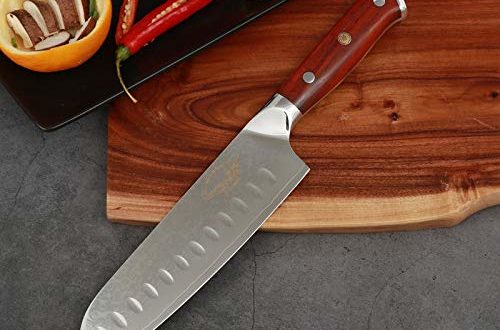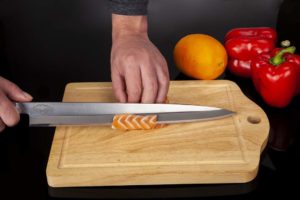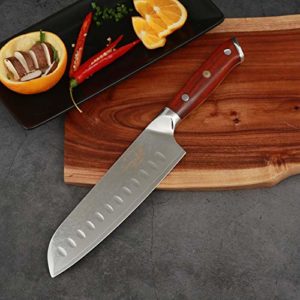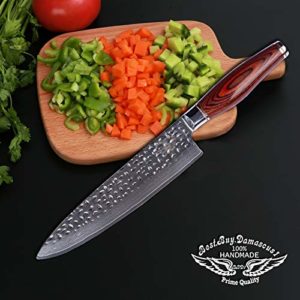Damascus Steel Chef Knife versus Santoku. What differences?
We are often asked what is the difference between a Damascus steel chef knives and a santoku . We try to answer this question in this article. The big difference lies in the shape of the blade. While the blade of a chef’s knife ends in a sharp point, the tip of a santoku knife diagonally moves from the back of the blade. Therefore, these two types of knives require a different cutting technique when using them.
Damascus Steel Chef Knife
A Damascus steel chef’s knife usually has a blade 20 cm long. There are also smaller chef’s knives with a blade about 16 cm long. Professional chefs give preference to even longer knives. The blade height of Damascus steel chef’s knives is about 4 to 5 cm. This height makes it possible to position the fingers with which the food is held slicing against the blade. We can work quickly and safely.
A Damascus steel chef’s knife is the indispensable basic knife in any kitchen. It is a versatile knife that is suitable for slicing vegetables, meat and fish; it can also be used as a chopper for finely chopping the herbs. For this operation we move the knife up and down against the finger. In this way the tip of the knife is always in contact with the cutting board. This creates a pendulum movement.
Santoku kitchen knife
From Asia, the Santoku kitchen knife is the Japanese version of the chef’s knife. Unlike the chef’s knife, the blade is almost the same drop over its entire length; it is curved only near the tip, diagonally from the back to the edge. A santoku is also shorter and lighter than his European brother. This makes it very popular.
When using a santoku kitchen knife, the cutting technique differs from that of a chef’s knife. Because of its flat blade, santoku does not perform rocking motion like a chef’s knife. The santoku kitchen knife is held horizontally by its handle to slice with a diagonal movement from the back down to the front. The blade loses contact with the board between each cutting movement. Fold the fingers of the hand with which you hold the food so as not to cut yourself. Our advice: train, train and train to learn to master this movement automatically.



